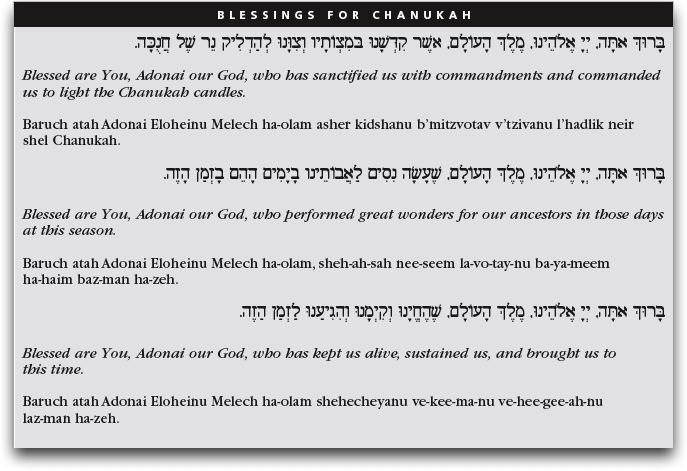

Questions and Answers for Chanukah 5766/2006
(Chanukah begins Sunday evening, December 25. The
last candle is lit Sunday evening, January 1, 2006.)
The Hebrew word "chanukah" means "dedication." The holiday derives its name from the Maccabean rededication of the Temple in Jerusalem on the 25th of the Hebrew month, Kislev, 165 B.C.E.
Prior to the year 167 B.C.E., the Land of Israel was ruled by a kingdom based in Syria under the cultural influence of Greece. A part of their ruling policy was a campaign to destroy Judaism.
In 167 B.C.E. on the 25th of Kislev, these "Greek-Syrians" entered the Temple in Jerusalem, defiled it by constructing altars to idols and began conducting pagan rites. That same year the Jewish people, under the leadership of Mattathias of Modin and his son, Judah, began a revolt. For three years Judah and his followers, who became known as Hasmoneans or Maccabees, waged a fight for religious freedom. Finally, in 165 B.C.E., they dislodged the enemy from large portions of Judea, gained control of Jerusalem, and restored the Temple.
On the 25th day of Kislev, the same date the Greek-Syrians had occupied the Temple, the Maccabees rededicated it.
According to the Apocrypha, where the Chanukah story is found, the ceremony of rededication, like Sukkot, lasted eight days. Some scholars believe that the
period of eight days was chosen for Chanukah because during the revolt Jews had not been able to get to the Jerusalem Temple to celebrate the Fall Festival of Sukkot. With the Temple back in Jewish hands, the Maccabees combined aspects of Sukkot and the rededication process. The result was an eight day Chanukah celebration echoing the eight days of Sukkot.
Was there a miracle whereby one day's worth of sacred oil for the Temple burned for eight days? Of the five ancient sources on Chanukah, only one relates the familiar story of the oil miracle. All sources agree, however, that the victory of the Maccabees was itself an
event of amazing importance that did "miraculously" save Judaism for the future.
Questions and Answers
How do we observe Chanukah today?
Chanukah is almost entirely a time for celebration, although it can be more than that. This year, for example, how about dedicating one Chanukah night to tzedakah? Give your gift(s) to Sinai’s own Isaiah Fund for the Hungry, which helps feed the hungry in our community or choose a charity of your own liking.
How do we prepare the candles when Chanukah arrives?
Place the candles in the chanukiah (Chanukah menorah) from right to left.
How many candles are used?
On the first night of Chanukah one light is kindled. On the following night, two lights and so on until on the eighth night, eight lights are kindled. This does not, of course, include the shammas which is the candle used every night to light the other candles of the day.
Where does the chanukiah go?
If possible the chanukiah should go near or at a window. In this way passersby can see the burning candles, which means according to Jewish tradition, that we have helped in the process of Pirsum Ha-nais--the Publicizing of the Chanukah Miracle and Story.
How do we light the candles?
Just after nightfall, say the blessings. The first two are said every night. The third is only said on the first night.
After the blessings light the candles by going from left to right so that the additional light of each night is kindled first.
Do we do anything different on Shabbat (Friday evening, December 10)?
Yes. On that night we light the chanukiah first and after that Shabbat candles. For a really good time, don’t do your candles at home. Bring yourself and your candles to Temple for a service, dinner, and more.